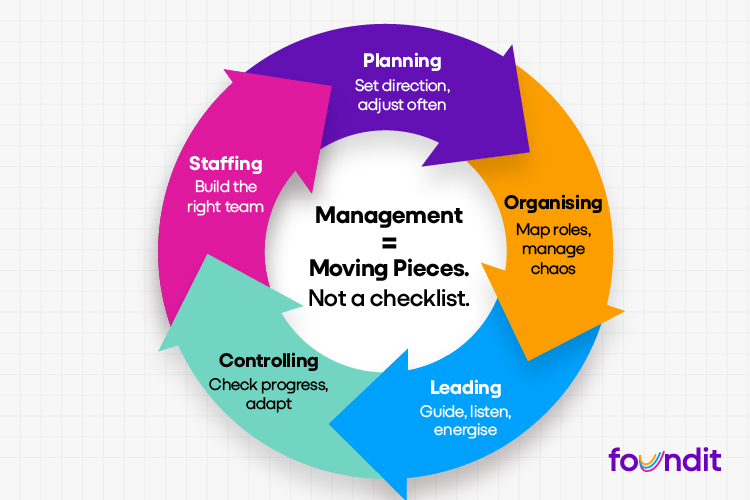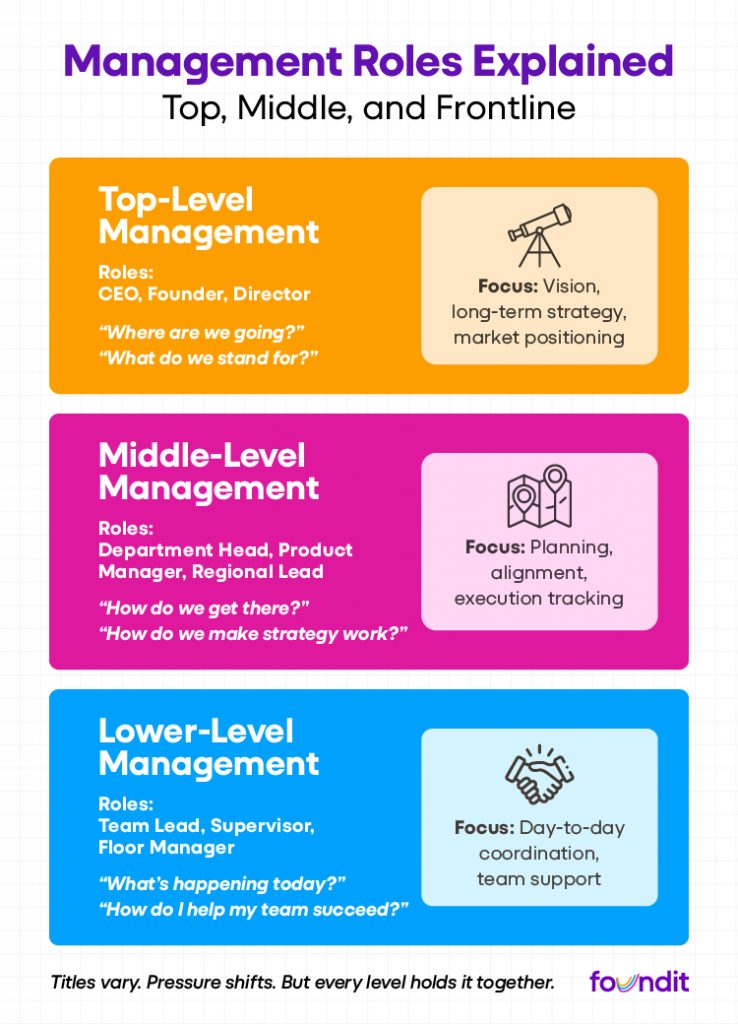What is Management? Definition & Meaning
Management is the process of guiding people, tasks, and resources in the right direction to achieve specific goals. It’s not just about giving instructions — it’s about setting priorities, removing roadblocks, and creating systems that help teams work smarter. Whether you’re managing a team of five or an entire organisation, the goal remains the same: to get results through effective planning and coordination.
At its core, management involves four key elements: planning, organising, leading, and controlling. These functions help align teams, optimise resources, and measure outcomes. A good manager knows when to take charge, when to delegate, and when to adapt — especially in fast-moving environments where things rarely go as planned.
There’s no one-size-fits-all definition of management, because how it’s applied often depends on the context — a hospital, a tech startup, a retail chain, or a school will all have different needs. But across industries, one thing is clear: management is what transforms ideas into action.
In business, the meaning of management extends beyond supervising people. It includes shaping company strategy, nurturing culture, and making tough calls that affect both profit and people. Understanding what management really means is the first step toward becoming a better leader — or recognising good leadership when you see it.
Read Also: Modern Theory of Management: [Types and Benefits]
Why is Management Important?
It’s easy to overlook, especially when things are running smoothly. But the truth is, without management, very little actually gets done — at least not in a consistent, meaningful way. Good ideas might surface, sure. A few things might even move forward on their own. But without someone to tie it all together, most efforts tend to scatter.
Management matters because it brings structure to ambition. It translates goals into action. Sometimes that’s through planning and schedules; other times, it’s just knowing when to say no, or when to let people run with an idea. And that balance isn’t always obvious — even experienced managers get it wrong now and then.
In teams, especially cross-functional ones, management creates a kind of shared rhythm. It sets expectations, keeps people aligned, and steps in when things drift off course. You could argue it’s the glue — not the flashy part, maybe not even the loudest voice in the room — but often the reason things don’t fall apart.
There’s also the human side of it. A good manager doesn’t just push for output; they understand people — what motivates them, what burns them out. That part of management is hard to define, yet it might be the most important of all.
5 Key Functions of Management
Most definitions of management boil down to a few core functions, i.e., planning, organising, leading, controlling, and sometimes staffing. You’ll see these in almost every business textbook, but in real life, they don’t always happen in neat steps. Often, they overlap. Or they loop back on themselves. Still, they’re useful markers for understanding how management actually works.

1. Planning
It is usually the starting point. It’s about asking, “Where are we going?” and “What’s the best way to get there?” But plans can be fragile — markets shift, team bandwidth changes, priorities collide. So the best managers treat plans as living documents. Flexible, not fixed.
2. Organising
It follows close behind. Once there’s a plan, someone needs to figure out who’s doing what, what resources are needed, and how everything connects. It sounds logical enough, but honestly, this is where many projects go off track. A great plan with poor coordination? That’s a missed opportunity waiting to happen.
3. Leading
This might be the most visible part. It’s the manager’s role to keep people motivated, engaged, and moving in the right direction. But it’s not all about pep talks or performance reviews. Often, it’s quiet things — checking in at the right time, giving feedback that actually lands, or just… listening.
4. Controlling
The ‘controlling’ term is a strange word — sounds harsher than it really is. It simply means tracking progress and making adjustments. Are we hitting the target? Is the team overloaded? Do we need to course-correct? Without this feedback loop, even the best plans eventually lose steam.
5. Staffing
Some frameworks leave it out, but it deserves a mention. Hiring the right people, onboarding them well, placing them in the right roles — that’s foundational. You can’t manage well without first building a team that can actually deliver.
In theory, these five functions are separate. In practice, they blur. A good manager doesn’t just tick them off. They move between them constantly, adjusting based on what the situation needs.
Roles and Responsibilities of Managers
The word “manager” can mean a lot of different things depending on where you are and what you do. A project manager in a tech startup doesn’t face the same day as a plant manager at a manufacturing site — and yet, the expectations overlap more than you might think.
In most workplaces, a manager’s role sits at the intersection of people, process, and performance. They’re expected to set direction, track progress, and make sure no one falls through the cracks. But that’s just the surface.
People leadership is often front and centre. Managers coach, mentor, resolve conflicts, and sometimes just listen. A good one knows when to step in — and when to step back. It’s rarely about being the smartest person in the room; it’s more about helping others do their best work.
Task ownership is the other half. Managers are responsible for deliverables, timelines, budgets — the nuts and bolts that keep things moving. This is the part that gets tracked in dashboards and project trackers. The visible part. But without strong people skills, even flawless execution can fall flat.
Managers also act as connectors between teams, departments, and sometimes even between company goals and individual effort. That’s why communication is such a critical skill—not just what they say but how they listen and translate priorities.
Of course, roles can stretch or shrink depending on seniority. A line manager might be focused mostly on daily coordination, while a senior manager balances cross-functional strategy. And somewhere in between, there’s a whole spectrum of messy, evolving responsibilities no one fully warns you about.
So while job descriptions may list a neat set of duties, the reality is more fluid. Being a manager is as much about adapting as it is about executing. It’s a mix of structure and intuition, goals and gut instinct. And that’s what makes it interesting — and, honestly, a little exhausting at times.
Types and Levels of Management
Management doesn’t happen at just one layer of an organisation. It stretches across levels — from those setting strategy at the top to those handling day-to-day execution on the ground. And while job titles vary wildly, the structure underneath is usually divided into three main levels: top, middle, and lower (or first-line) management.

Top-level management
It includes roles like CEOs, founders, directors, and senior executives. These are the people making long-term decisions — the kind that shape a company’s vision or steer it into new markets. They’re often less visible to frontline teams, but their choices ripple down through every department.
At this level, the job isn’t about micromanaging tasks. It’s more about questions like: “Where are we headed?” and “What do we want to stand for?” That said, top-level managers also rely heavily on input from below — strategy without ground-level insight is just guesswork, after all.
Related: Role of Top Management in Company’s Growth
Middle-level management
This stage is where the real translation happens. These managers bridge big-picture goals with real-world action. Department heads, product leads, regional managers — they’re the ones converting company strategy into roadmaps, KPIs, hiring plans, and sometimes, endless slide decks.
They face pressure from both sides. They need to deliver results upwards and make things manageable for their teams below. It’s not an easy place to be — the middle often absorbs the most ambiguity.
Lower-level (or first-line) management
It is closest to the actual work. These are team leads, supervisors, shift managers — the people keeping things running hour by hour. They manage individuals more than strategy, but their impact is immediate and visible.
The funny thing? Many of the hardest management lessons are learned here — in the details, in real-time feedback, in helping someone grow. You don’t need a corner office to be a real manager. This level proves that daily.
Of course, some companies flatten these layers or call them different things. Startups, especially, tend to blur boundaries. But in most cases, these levels still exist — formally or informally — shaping how decisions are made and how work flows through the system.
Top Skills Every Manager Should Have
There’s no universal formula, no perfect set of traits. But still — over time, certain patterns show up. Ask anyone who’s worked under a great manager (or a bad one), and you’ll start to hear the same things.
1. Communication
Not just speaking clearly or writing good emails — though those matter. It’s more about knowing when to speak, when to pause, and how to explain things in a way people actually understand. The best managers aren’t necessarily the loudest, but they’re rarely misunderstood.
2. Empathy
Empathy isn’t always taught, but it’s felt. A manager who checks in when someone’s struggling, who listens without rushing to fix things — that leaves a mark. It builds trust faster than any pep talk or policy ever could.
3. Decision-Making
It’s not just about having the final say — it’s about making calls when things are unclear. Or when both options kind of suck. The ability to choose, explain why, and own the outcome? That’s underrated.
4. Delegation
New managers often try to do everything themselves. It feels safer. But real leadership means letting go — assigning tasks, trusting others, and yes, sometimes watching things get done differently than you would’ve liked.
5. Adaptability
Projects change. Teams shift. Priorities flip overnight. Managers who stay rigid usually break under pressure. The ones who adjust, rethink, regroup — those are the ones people want to work with again.
Could we add more? Sure. Time management, conflict resolution, strategic thinking… the list never really ends. But most great managers aren’t perfect. They’re just aware. They keep learning. They ask better questions. And that, often, matters more than ticking every skill box.
Related: Management Skills: Concepts, Importance, and Tips
Careers in Management: Paths and Opportunities
Not everyone sets out to be a manager. For some, it starts with a promotion. For others, it’s a gradual shift — mentoring teammates, leading projects, stepping into decisions no one else wanted to make. And suddenly, you’re managing.
Common Ways People Move into Management
In many industries, people move into management from technical or operational roles. An engineer becomes a team lead. A sales rep becomes a regional manager. Sometimes it’s a formal transition. Other times, it just… happens, without clear training or support.
That’s why early management roles — especially first-line managers — are often the steepest learning curve. You’re suddenly balancing your old tasks with new responsibilities like coaching, hiring, or conflict resolution. And no, it’s not always smooth.
Vertical vs Lateral Growth in Management
Career growth isn’t always about moving “up.” Sometimes it’s sideways. A manager might switch departments, industries, or even shift into project-based roles like program management or change management. These lateral moves build range — not just rank.
That said, vertical growth does exist — from team lead to manager to director to VP. But the jump from one level to another often involves more than performance. It’s about visibility, influence, and the ability to think beyond your immediate team.
Management Career Paths by Sector
Management roles show up in every industry — but the nature of the work varies.
- Tech: Product Managers, Engineering Managers, Program Managers
- Retail & Operations: Store Managers, Area Supervisors, Logistics Managers
- Finance: Portfolio Managers, Branch Managers, Team Leads
- Healthcare: Department Heads, Shift Supervisors, Admin Managers
What Makes Management a Long-Term Career
For many, management becomes less about title and more about impact. You’re not just solving problems — you’re building systems that solve problems. You’re not just leading meetings — you’re shaping culture. That shift from control to influence is what turns a job into a career.
Still, it’s not for everyone. And that’s okay. Some people step into management, try it, and step back. Others grow into it slowly. The path isn’t fixed. And that’s what makes it worth exploring.
FAQs About Management
Q1. What is the simple definition of management?
Management is the process of planning, organising, leading, and controlling resources — including people — to achieve specific goals efficiently.
Q2. What are the 5 main functions of management?
The five key functions are planning, organising, leading, controlling, and staffing. These help ensure work gets done, teams stay aligned, and goals are achieved.
Q3. What are the 3 levels of management?
Management is often divided into top-level (executives), middle-level (department heads), and lower-level (team leads or supervisors) roles — each with unique responsibilities.
Q4. Is management only about giving orders?
Not at all. Good management is more about support than control. It includes mentoring, decision-making, and building a healthy team environment.
Q5. Can you become a manager without formal training?
Yes. Many managers grow into their roles through experience. While training helps, hands-on learning, mentoring, and adaptability often matter more.
Q6. What industries need strong management?
All industries rely on management — from tech and healthcare to retail, finance, education, and manufacturing. The role just looks different in each one.
Q7. Is management the same as leadership?
They overlap, but they’re not identical. Leadership inspires and sets vision. Management ensures that vision gets executed — on time and on target.




